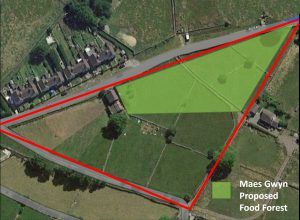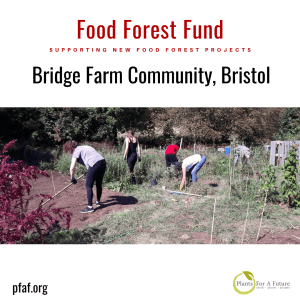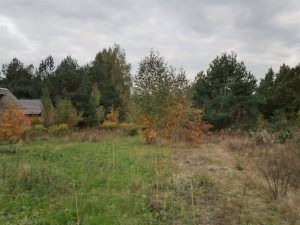Plants For A Future and the Transition Movement
The Plants For A Future (PFAF) research project and the Transition Network (originally Transition Towns) both came from permaculture (‘permanent culture’ and ‘permanent agriculture’). Ken Fern, who created PFAF in 1989, explained in his book Plants For A Future that he discovered permaculture without realising it via a book about Forest Farming. He was seeking a better way to produce food than growing organic vegetables by hand, and found that permaculture – as ‘permanent agriculture’ – gave him ‘a method of plant management that tries to emulate the natural ecosystems of the planet, to work in harmony with nature’.[1] Rob Hopkins, co-founder of the Transition Network in 2006, was a permaculture teacher concerned about climate change, who viewed The End of Suburbia, a disturbing American film about Peak Oil, and saw that crisis as an opportunity to rebuild local communities – ‘permanent culture’ – in order drastically to reduce consumption of fossil fuels, avert climate change, and restore ‘harmony with nature’.
There are many connections between Plants For A Future and Transition: both encourage and assist local self-reliance and sustainability. Another strand of support for these goals is the work we have been doing recently at PFAF to enhance and refine our database to include key plants identified in the work of Eric Toensmeier on edible forests, and by Paul Hawken on reafforestation to draw carbon down from the atmosphere.[2]
Plants For A Future and Incredible Vegetables
In 2017 two PFAF trustees, Wendy Stayte and Chris Marsh, began a research project involving making cooperative links with people in the South West growing unusual plants in innovative ways. They began with a visit to Incredible Vegetables near Ashburton, where they were shown around by Mandy Barber (www.incrediblevegetables.co.uk ). We made notes and took photographs, and published the resulting photo essay on the website at http://www.pfaf.org/user/Research.aspx?id=307. Trevor Pemberton, our database administrator came with us on a later visit to Incredible Vegetables that year. We all were thrilled and delighted by the gorgeously productive and beautiful site, and impressed by what Mandy had achieved, her knowledge, skills and love of edible plants, and her research projects directed at saving rare varieties of perennial brassicas. When we decided to bring out a new book in our series of guides, this one on Edible Shrubs, we asked Mandy if she would write a Foreword to the book and she agreed. Mandy and Chris met to discuss this and Mandy mentioned that she was going to give a talk to Teign Estuary Transition group (https://teigntransition.org.uk/ ). Chris is a member of Dawlish Transition group, and decided to go to this event and to make notes on the talk to write up later for the PFAF blog.
It is thought that the now familiar saying ‘Think globally, act locally’ originated with the sociologist and pioneer of town planning Patrick Geddes,[3] and was then adopted in 1969 by David Brower, founder of Friends of the Earth. We have a good instance of that principle in the connection between the idea of addressing climate change by global reafforestation with practical local projects like Incredible Vegetables. Clearly Transition towards local self-reliance and sustainability must be acted upon, not just talked about and campaigned for, but where do we start? Very often we start with local food. Lester Brown, president of the Earth Policy Institute, has written about the local food movement worldwide, and how millions of these initiatives have arisen spontaneously, not requiring changes in government policy, legislation, regulation etc.[4] Local food is certainly important for Transition groups, many of which involve their members and others in the work of maintaining and harvesting in their community gardens, or in other activities such as local food markets, garden share schemes and seed swaps. Many groups also invite speakers to talk about food growing, as Teign Estuary Transition did when they arranged for Mandy Barber to talk about Incredible Vegetables.
Mandy Barber talks to Teign Estuary Transition about Perennial Vegetables
On 26 March 2018, as part of their programme for Earth Week, Teign Estuary Transition invited Mandy Barber of Incredible Vegetables to give a talk on ‘Perennial Vegetables’. Chris Marsh, Trustee of Plants For A Future, and also a member of Dawlish Transition, joined a packed audience of gardening and local food enthusiasts at the Teignmouth Arts Action Group (TAAG) Centre. Mandy showed slides of how a patch of sheep pasture had been transformed into a thriving garden of perennial greens, flowers and roots, in a flowing and evolving design, all organic, no dig and wildlife friendly. Her talk was focused on her favourite 10 edible vegetables, which can provide spinach, broccoli and kale, roots and alliums for an all-year-round living larder. Afterwards people queued up to buy the plants Mandy had brought along.
Mandy began by telling us about her experimental growing space on a hill overlooking Ashburton, a small town on the edge of Dartmoor in south Devon. She is passionate about perennial vegetables, both researching and growing plants which continue for many years, some of them capable of surviving for a century or more. For eight years Mandy has co-owned this field with a group of like-minded friends, who pooled all the money they could raise to purchase the plot when it came up for sale. When they bought the field it was typical Dartmoor sheep pasture.
Mandy showed us slides of the field after one year, and then after two years, when it had been transformed into a polyculture. It was laid out in a design initially, but they don’t believe in growing in straight lines so there were few restrictions, except where there was a need to avoid planting annuals in the same area, as with potatoes. They planted flowers, vegetables and fruits in the same space, for the sake of beauty and diversity, to help prevent a build-up of pests, and to benefit wildlife. They have seen an increase in the butterfly count, and a big increase in diversity of species including pollinators. There is a rambling mix of flowers and vegetables, including many edible flowers which spread naturally around the site.
The site has been ‘no dig’ from the start. They mulched over the original meadow grass with compost and cardboard in stages, and they found that it all rotted down over a year. Since then they have avoided turning the soil, and sow green manures, especially clover, on any bare soil, such as between newly planted brassica plants once they have grown big enough, i.e. 8-10 inches. They also sow phacelia, later chopping down the plants, either leaving the material where it was, or gather it up to put between plants, which protects the soil. Phacelia flowers in a couple of months, which the bees love.
Mandy then described her Top 10 edible perennials.
1. Hablitzia Tamnoides or Caucasian spinach
https://www.pfaf.org/user/Plant.aspx?LatinName=Hablitzia+tamnoides
Hablitzia Tamnoides is a herbaceous perennial climber from the Caucasus region with edible spinach type leaves. It has been grown in the manor houses of Scandinavia and in various botanical gardens in the UK and North America since the early 19th century as an ornamental plant. Although its edible properties have been known for a long time it wasn’t until Swedish author Lena Israelsson wrote about it in her book ‘The Kitchen Garden: Our Green Heritage’ and an article in permaculture magazine by author Stephen Barstow that interest in Hablitzia developed as a really useful edible plant for forest gardens.
Hablitzia grows rapidly between March and May and can reach up to 3m in height. The leaves provide a harvest of tender edible spinach from April to July. After producing flowers in the summer, it dies back and in late winter/early spring you see a crown of young shoots emerge which form the next year’s growth. As the plant matures the crown gets larger each year, with 250 shoots or more. Hablitzia is easy to grow from seed but it does need a period of cold to germinate. This can be done by sowing in the Autumn and leaving outside in a cold frame and they will naturally germinate in the spring or by putting them in the fridge for ten days. Mature plants can be split in Autumn by dividing the crown carefully with a sharp knife. Hablitzia will happily grow in a semi-shady spot and will climb up trellis, bean netting or wind its way through other plants for support. Stephen Barstow has subsequently written about Hablitzia in his extensive book ‘Around the World in 80 Plants’ and this has helped Hablitzia undergo somewhat of a renaissance in recent years. There now seems to be a bit of a craze for Hablitzias – or ‘habbies’ and there is even a Facebook group ‘Friends of Hablitzia Tamnoides’ where you can post pictures of your plants. As an edible it has a delicate taste and can used raw in salads, wilted like spinach, made into fritters and is a welcome spring treat. The early shoots can be eaten too.
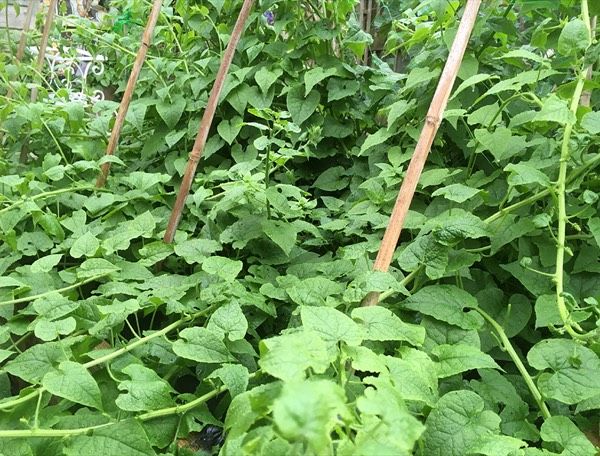
2. Skirret.
https://www.pfaf.org/user/plant.aspx?LatinName=Sium+sisarum
Skirret is a plant that produces a cluster of sweet tasting parsnip like roots. It was one of the main root vegetables grown in Europe before potatoes became really popular and had its heyday in the 16th and 17th century. They were used in many dishes adding sweetness at a time when sugar was rarely available. By the 19th Century Skirret barely gets a mention and falls out of favour. But now there is renewed interest in this vegetable, which, with a bit of attention and some breeding work could become a mainstay of the perennial vegetable garden.
Skirret can be grown as a perennial and plants can be left in the ground for 2 -3 years for the roots to mature. The crowns can be divided up and use some roots for eating and leaving some aside for propagating. The crown sections can be re-planted and also off-sets can be carefully pinched off the top of the plants in spring and potted up for rapid propagation. Skirret produces seed too, but for successful germination seeds need to be very fresh and require bottom heat from a propagator of 20 C for about a month, or up to seven weeks. They are erratic germinators! The foliage can reach over 2m tall and the flowers attract hover flies, so are both beneficial and attractive. In the autumn they self-seed but are not invasive. To prepare them you give them a good scrub and then use as any root vegetable. Delicious sautéed with herbs, or roasted, or as a sweet raw treat straight from the veg garden.
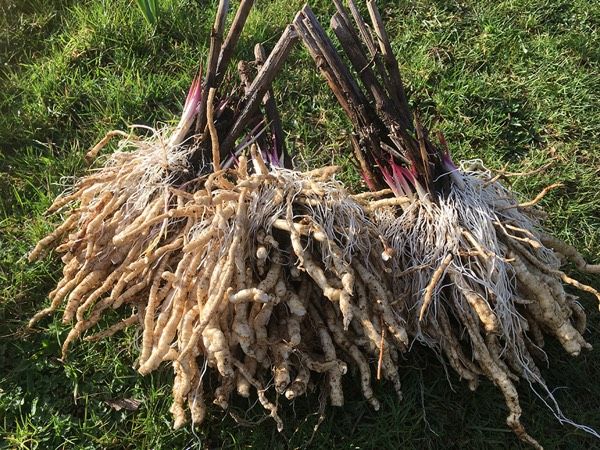
3. Nine Star Perennial Broccoli
https://www.pfaf.org/user/Plant.aspx?LatinName=Brassica+oleracea+botrytis+aparagoides
This plant was the first to stir Mandy’s interest in edible perennials, when she was looking for an easier way to grow food than the usual slog with annuals. Perennial vegetables have great advantages in being low maintenance, locking up more CO2, being more resilient to pests and the uncertainties of climate change. They will also thrive in the shady and marginal spots of your garden where no annual plant would dare to grow and they also have the ability to gather more nutrients and anti-oxidants spending many years in the ground. They quite often are at their best in early spring when there is not much else to harvest from annual plants. Planting perennials and annuals together can give you a year round harvest.
Perennial Nine Star Broccoli is an amazing hardy vegetable that produces a central large creamy white cauliflower type head with a myriad of sprouting side shoots from as early as February through to May. To keep the plants sprouting year after year you have to cut off all the florets for eating and any flowers that try to emerge so you don’t allow the plants to go to seed. The following spring you will get another crop of edible florets and for several years after that. Plants can grow up to a metre tall and wide so leave plenty of space between them. They will need staking once mature. Plants can go on producing for up to 5 years in some cases. The florets can be used in the same way as regular cauliflower or broccoli.
The plant was originally developed by Charles Curtis from Cambridgeshire who bred it (around 1928). Currently both seed and plants of this variety are becoming increasingly difficult to obtain as larger commercial growers no longer cultivate it. Compared to other brassicas, Nine Star produces a lot less seed so only small independent nurseries and growers continue to work with it. There are a handful of plant breeders dotted around the world who are currently trying to breed and improve the crop. The problem has been an ever shrinking pool of seed, which has led to a lack of genetic diversity. Mandy is working on a Nine Star field trial to see if she can produce vigorous crops with long lasting perennial habits.
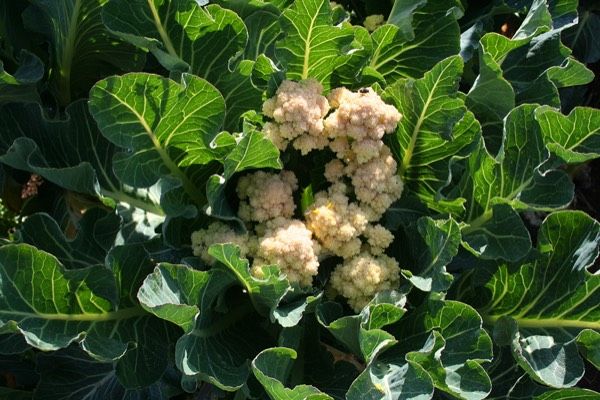
4. Taunton Deane Kale also known as Cottagers Kale
https://www.pfaf.org/user/Plant.aspx?LatinName=Brassica+oleracea+ramosa
the latin name is (Brassica oleracea var Acephala) for Taunton Deane kale
There are many kinds of perennial kales, but Taunton Deane has to be the tastiest and most prolific of them all. It can grow for 5-9 years and the delicious leaves can pretty much be harvested all year round. On Mandy’s site there are plants which are monsters of green leaves growing up to 3-4 metres wide with big trunks. Because it only occasionally flowers it has been traditionally passed on by means of cuttings rather than seed. Once you have a mature plant you can propagate endlessly by taking stem cuttings. They will root easily within 3-4 weeks once popped into a pot of compost.
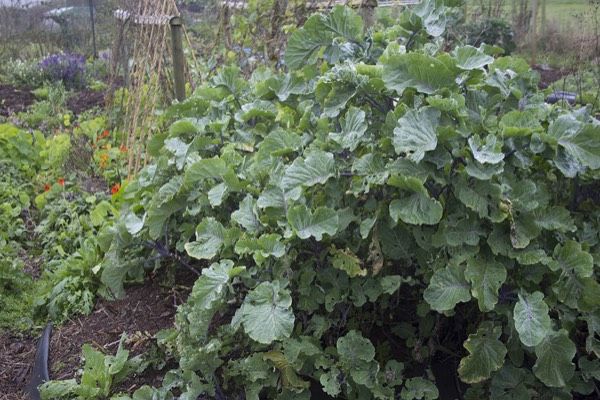
5. Purple Tree Collard
http://www.incrediblevegetables.co.uk/purple-tree-collards/purpletreecollard-sq/
This long lived perennial brassica which has been known to grow for up to 20 years and produces a head of dark purple edible leaves. Although cultivated widely in the states it seems to be an elusive plant in the UK. Mandy is taking cuttings with the aim of making a botanically safe collection to offer to other sites.
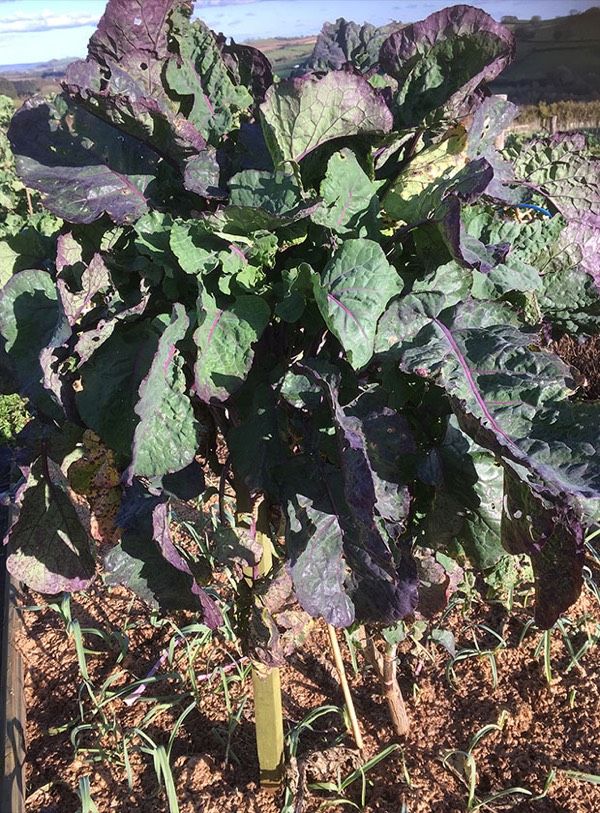
6. Chinese Artichoke
https://www.pfaf.org/user/plant.aspx?LatinName=Stachys+affinis
Chinese Artichoke produces a prolific amount of delicious crunchy tubers and is valuable addition to the perennial vegetable garden because it offers a winter harvest from October through to March. Being very hardy, tubers can be left in the ground and just lifted when needed. It is a relative of the mint family and is virtually indestructible and very resistant to pests and diseases. It is good in a stir fry because it absorbs flavours, and is also good added to pickles.

7. Yacon or Peruvian Ground Apple
https://pfaf.org/plants/yacon-strawberry-smallanthus-sonchifolius/
This a South American plant closely related to Jerusalem artichoke and sunflower. It produces large edible storage tubers which are refreshingly juicy and taste somewhere between a pear and watermelon. The tubers become sweeter after harvest if left on a sunny window sill. It forms a cluster of rhizomes at the top which you can use to propagate new plants, taking up to 10-20 from the top of each. You can carefully divide these and pot them up and each rhizome section will produce a new plant. Yacon can be grown as an annual or perennial. In milder areas plants can be earthed up and over wintered and will form new foliage in the spring.
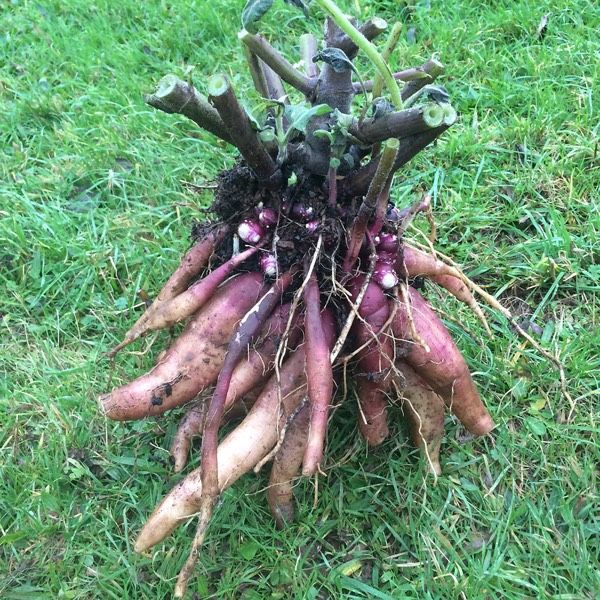

8. Mashua
https://www.pfaf.org/user/plant.aspx?LatinName=Tropaeolum+tuberosum
Mashua is a South American plant and is a relative of Nasturtium and produces edible tubers, leaves and flowers. Tubers can be started off under cover and then planted out when all risk of frost passed. Alternatively you can plant the tubers direct end of May. The foliage will happily trail horizontally or will climb up any support you give it. Tubers start to form after the Autumn equinox and usually plants are lifted once the first hard frosts hit the top growth. Usually harvest October/November time. The flowers come late in the season and this is a sign that tubers are starting to form. Flowers have a delicate aniseed taste and can be added to salads. The nasturtium type leaves can be used as a spicy salad leaf through the growing season. Harvested tubers can be cooked by roasting with herbs and olive oil and have a turnip like flavour. Save some tubers for re-planting the following year.
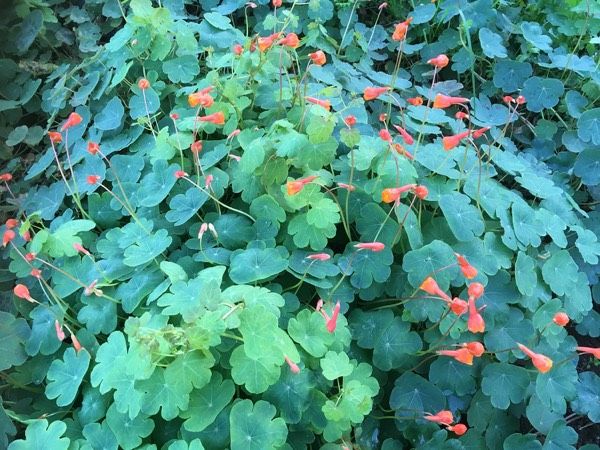
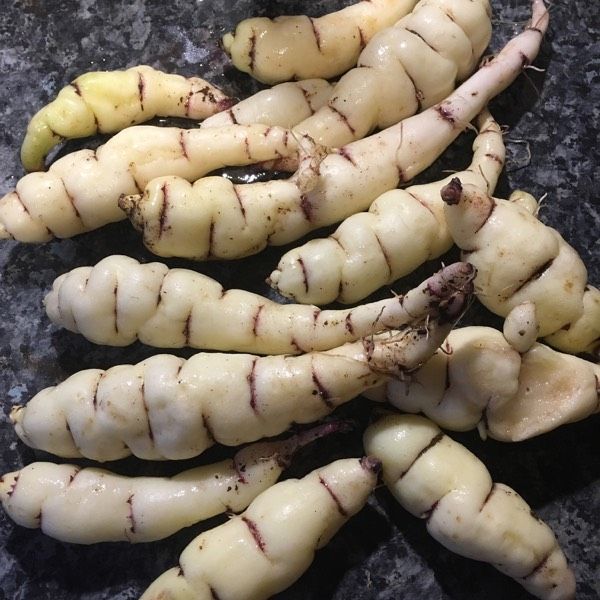
9. Babington’s Leek
https://www.pfaf.org/user/Plant.aspx?LatinName=Allium+ampeloprasum+babingtonii
There are several alliums suitable for growing in small spaces. Babington leeks, Allium Ampeloprasum var Babingtonii, is one of the tastiest and easy to grow perennial vegetables. Named after Charles Cardale Babington, this wild and hardy perennial leek is a native sea shore plant and perennial ancestor to garden leeks. It is extremely low maintenance and ideal for polyculture spaces as it will thrive between other plants and can tolerate a range of soils and positions.
It can be grown by sowing bulbils, or by obtaining a mature bulb or plant. To harvest, simply cut the leeks at the base and leave the bulbs in the ground to re-grow. Harvesting time is usually March to June.
Babington leeks are so tasty that you will want to harvest them all, but if you want to increase your stock quickly you need to let some of them flower. The leeks will throw up a very tall stem around July time with very attractive purple flowers. These in turn go on to produce a head of bulbils, each bulbil producing a new leek. The head will naturally bend and plant itself or you can gather bulbils and separate them when the cases are papery and sow in a new spot. As the plants mature, they produce a very large underground bulb with a cluster of ‘mini bulbs’ or offsets which will form clumps of new growth above ground. You can lift and separate and move bulbs around when they are in their dormant stage.
You will find leeks popping up in strange places as bulbils sometimes get flung a distance, but it is exciting when that happens! It takes patience to establish a Babington colony, but well worth it and you will have them forever. The life cycle of the leeks is: Emerge in late Autumn/early winter, harvesting period March to June, flowers emerge July to August ( from plants that have not been cut for harvesting), Bulbils can be collected in August, plants die back by end of September. As each year passes the underground bulbs become larger.
Babington Leeks – flowers, stems, bulbs and bulbils are all edible. The leeks have a deep savoury taste and make the most delicious base for soups, are great in omelettes, or just simply sautéed in a pan. They have a garlicky hit too which just adds to their many culinary uses.
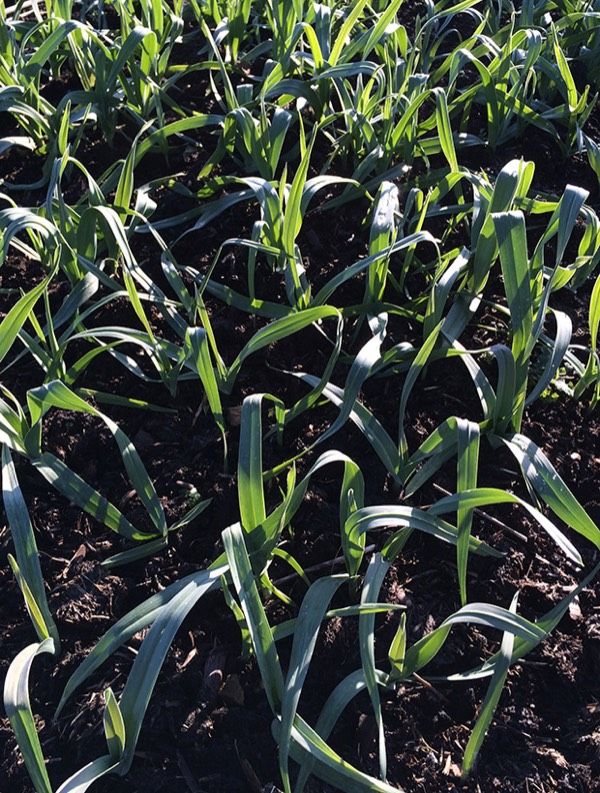
10. Walking Onion
https://www.pfaf.org/user/plant.aspx?latinname=Allium+cepa+proliferum
Walking onions can be used as a perennial spring onion, you can harvest the green tops for most of the year. The plants produce a cluster of aerial small onions which bend over and re-root themselves, hence the name ‘walking onion’. Over time it will gradually colonize a space. The aerial bulbs are also delicious and can be divided up and planted in a new spot too.
Mandy also mentioned a Citizen Science project which she suggested people might like to join in with. It has been launched by The Guild of Oca Breeders (http://ocabreeders.org/ ) The Guild of Oca Breeders (GOB) is a citizen science plant breeding club that aims to improve the Andean vegetable oca (Oxalis tuberosa) for cultivation in the Northern European growing environment. Oca is a high-altitude Andean tuber crop native to South America. It’s been grown occasionally in the UK for over 150 years but has yet to become a commercial success. The delicious tubers are short-day plants, which means they only start to form when summer ends and the nights grow longer. Unfortunately, this also leaves them vulnerable to cold and frost and gardeners are discouraged by poor crops. The mission of the Guild is to breed a variety of oca that responds much better to European variations in day length and climate. Anyone with horticultural experience can get involved with the project.
Mandy concluded by saying that edible perennials can supplement or be a big part of your diet. They help you plan for all year round produce, with many perennials coming in the ‘hungry gap’ from winter through to spring, complementing your growing system and providing a living larder.
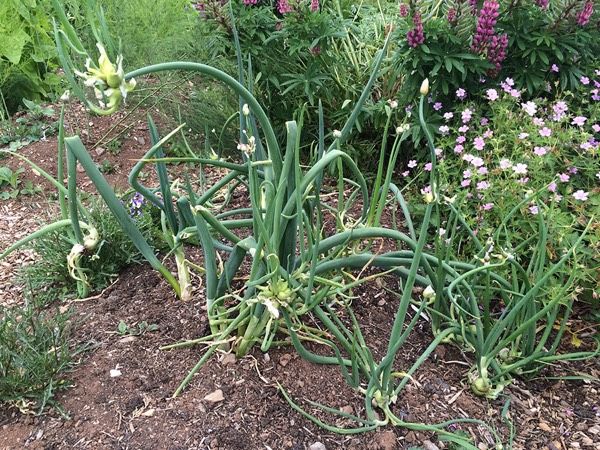
Conclusion: Spreading the Food Forests Revolution
What is really exciting about what Mandy Barber is doing with her plants research and her talks is that she shows what is possible, what we can all do at however small a scale, to meet our most basic needs in a sustainable way, and to contribute to saving life on earth. It is also exciting that Plants For A Future has a role in this revolution, and we have a global reach through our website and database, and this blog.
[1] Ken Fern, Plants For A Future: Edible & Useful Plants For A Healthier World (Clanfield, Hants: Permanent Publications, 1997), pp. xi-xii.
[2] Eric Toensmeier, The Carbon Farming Solution: A Global Toolkit of Perennial Crops and Regenerative Agriculture Practices for Climate Change Mitigation and Food Security (London: Chelsea Green: 2016); Paul Hawken, Drawdown: The Most Comprehensive Plan Ever Proposed to Reverse Global Warming (London: Penguin, 2018); https://transitioncornwall.com/2015/12/21/paul-hawken-project-drawdown/
[3] Patrick Geddes, Cities in Evolution: A Introduction to the Town Planning Movement and to the Study of Civics (London: Ernest Benn, 1968 [1915[), p. 397.
[4] (World on the Edge: How to Prevent Environmental and Economic Collapse (London: Earthscan, 2011), pp. 175-78.)


